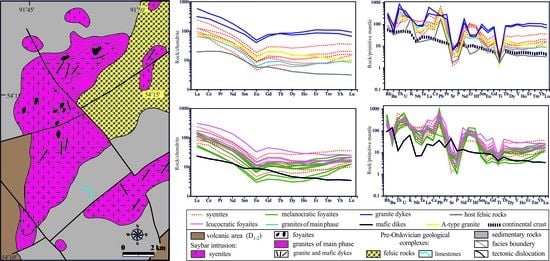Evolution of Syenite Magmas: Insights from the Geology, Geochemistry and O-Nd Isotopic Characteristics of the Ordovician Saibar Intrusion, Altai-Sayan Area, Russia
Abstract
1. Introduction
2. Geological Background and Petrography
3. Analytical Methods
3.1. Zircon U-Pb Dating
3.2. Whole-Rock Composition
3.3. O-Nd Isotopic Analysis
4. Results
4.1. Zircon U-Pb Geochronology
4.2. Major and Trace Element Geochemistry
4.3. O-Nd Isotopes
5. Discussion
5.1. Parent Magmas and Petrogenesis
5.2. Geodynamic Setting
6. Conclusions
Author Contributions
Funding
Data Availability Statement
Acknowledgments
Conflicts of Interest
References
- Rocks, I. Classification, Nomenclature, Petrography; Bogatikov, O.A., Gon’shakova, V.I., Eds.; Nauka: Moscow, Russia, 1983; Volume 1, pp. 1–372. (In Russian) [Google Scholar]
- Condie, K.C. Mantle Plumes and Their Record in Earth History; Cambridge University Press: Cambridge, UK, 2001; pp. 1–305. [Google Scholar]
- Ernst, R.E. Large Igneous Provinces; Cambridge University Press: Cambridge, UK, 2014; pp. 1–667. [Google Scholar]
- Burke, K.; Dewey, J. Plume-generated triple junctions: Key indicators in applying plate tectonics to old rocks. J. Geol. 1973, 81, 406–433. [Google Scholar] [CrossRef]
- Pirajno, F. Intracontinental anorogenic alkaline magmatism and carbonatites, associated mineral systems and the mantle plume connection. Gondwana Res. 2015, 27, 1181–1216. [Google Scholar] [CrossRef]
- Yashina, R.M. Alkaline Magmatism in Orogenic Areas (Case of the Southern Periphery of the Siberian Craton); Nauka: Moscow, Russia, 1982; pp. 1–274. (In Russian) [Google Scholar]
- Sheimann, Y.M.; Apeltsin, F.R.; Nechaeva, E.A. Alkaline Intrusions, Their Placement and Associated Mineralization; Gosgeoltekhizdat: Moscow, Russia, 1961; pp. 1–176. (In Russian) [Google Scholar]
- Sheimann, Y.M. Essays on Deep Geology; Nedra: Moscow, Russia, 1968; pp. 1–232. (In Russian) [Google Scholar]
- Litvinovsky, B.A.; Zanvilevich, A.N.; Burdukov, I.V.; Karmanov, N.S. Syenites as a product of fractional crystallization of alkaline-basaltic magma of the Oshurkovsky intrusion, Transbaikalia. Russ. Petrol. 1998, 6, 30–52. [Google Scholar]
- Allen, C.M.; Chappell, B.W. Assosiation of I type granites with rift related alkali magmatism in central coastal Queensland, Australia. Geol. Soc. Am. Abstr. Programs 1992, 24, 43. [Google Scholar]
- Lubala, R.T.; Frick, C.; Roders, J.H.; Walraven, F. Petrogenesis of syenites and granites of Schiel Alkaline complex, Northern Transvaal, South Africa. J. Geol. 1994, 102, 307–309. [Google Scholar] [CrossRef]
- Huang, W.L.; Wyllie, P.J. Phase relationships of S-type granite with H2O to 35 kbar: Muscovite granite from Harney Peak, South Dakota. J. Geoph. Res. 1981, 86, 10515–10529. [Google Scholar] [CrossRef]
- Brown, P.E.; Becker, S.M. Fractionation, hybridisation and magma-mixing in the Kialineq centre, East Greenland. Contrib. Mineral. Petrol. 1986, 92, 57–70. [Google Scholar] [CrossRef]
- Sheppard, S. Hybridization of shoshonitic lamprophyre and calc-alkaline granite magma in the early Proterozoic Mt Bundey igneous suite, Northern Territory. Aust. J. Earth Sci. 1995, 42, 173–185. [Google Scholar] [CrossRef]
- Barker, F.; Wones, D.R.; Sharp, W.N.; Desborough, G.A. The Pikes Peak batholith, Colorado front range, and a model for the origin of the gabbro-anorthosite-syenite-potassic granite suite. Precambrian Res. 1975, 2, 97–160. [Google Scholar] [CrossRef]
- Dorias, M. Compositional variations in pyroxens and amphiboles of the Belkmap Moutain complex, New Hampshire: Evidens for origin of silica-saturated alkaline rocks. Am. Mineral. 1990, 75, 1092–1105. [Google Scholar]
- Kröner, A.; Kovach, V.; Belousova, E.; Hegner, E.; Armstrong, R.; Dolgopolova, A.; Sun, M. Reassessment of continental growth during the accretionary history of the Central Asian Orogenic Belt. Gondwana Res. 2014, 25, 103–125. [Google Scholar] [CrossRef]
- Sengör, A.C.; Natal’in, B.A.; Burtman, V.S. Evolution of the Altaid tectonic collage and Palaeozoic crustal growth in Eurasia. Nature 1993, 364, 299–306. [Google Scholar] [CrossRef]
- Windley, B.F.; Alexeiev, D.V.; Xiao, W.; Kröner, A.; Badarch, G. Tectonic models for accretion of the Central Asian Orogenic Belt. J. Geol. Soc. Lond. 2007, 164, 31–47. [Google Scholar] [CrossRef]
- Coleman, R.G. Continental growth of North West China. Tectonics 1989, 8, 621–635. [Google Scholar] [CrossRef]
- Kröner, A.; Hegner, E.; Lehmann, B.; Heinhorst, J.; Wingate, M.T.D.; Liu, D.Y.; Ermelov, P. Palaeozoic arc magmatism in the Central Asian Orogenic Belt of Kazakhstan: SHRIMP zircon ages and whole-rock Nd isotopic systematics. Asian Earth Sci. 2008, 32, 118–130. [Google Scholar] [CrossRef]
- Rytsk, E.Y.; Kovach, V.P.; Yarmolyuk, V.V.; Kovalenko, V.I. Structure and evolution of the continental crust in the Baikal Fold Region. Geotectonic 2007, 41, 440–464. [Google Scholar] [CrossRef]
- Windley, B.F.; Kröner, A.; Guo, J.; Qu, G.; Li, Y.; Zhang, C. Neoproterozoic to Paleozoic geology of the Altai orogen, NW China: New zircon age data and tectonic evolution. J. Geol. 2002, 110, 719–739. [Google Scholar] [CrossRef]
- Yarmolyuk, V.V.; Kovalenko, V.I.; Kovach, V.P.; Rytsk, E.Y.; Kozakov, I.K.; Kotov, A.B.; Sal’nikova, E.B. Early Stages of the Paleoasian Ocean formation: Results of geochronological, isotopic, and geochemical investigations of Late Riphean and Vendian-Cambrian complexes in the Central Asian fold belt. Dokl. Earth Sci. 2006, 411, 1184–1189. [Google Scholar] [CrossRef]
- Yarmolyuk, V.V.; Kovalenko, V.I.; Kozlovskii, A.M.; Kovach, V.P.; Sal’nikova, E.B.; Kovalenko, D.V.; Kotov, A.B.; Kudryashova, E.A.; Lebedev, V.I.; Eenzhin, G. Crust-forming processes in the Hercynides of the Central Asian foldbelt. Petrology 2008, 16, 679–709. [Google Scholar] [CrossRef]
- Yarmolyuk, V.V.; Kovach, V.P.; Kovalenko, V.I.; Salnikova, E.B.; Kozlovskii, A.M.; Kotov, A.B.; Yakovleva, S.Z.; Fedoseenko, A.M. Composition, sources, and mechanism of continental crust growth in the Lake Zone of the Central Asian Caledonides: I. Geological and geochronological data. Petrology 2011, 19, 55–78. [Google Scholar] [CrossRef]
- Yarmolyuk, V.V.; Kuz’min, M.I.; Vorontsov, A.A. Convergent boundaries of the West Pacific type and their role in the formation of the Central Asian fold belt. Russ. Geol. Geophys. 2013, 54, 1427–1441. [Google Scholar] [CrossRef]
- Yarmolyuk, V.V.; Kuz’min, M.I.; Ernst, R.E. Intraplate geodynamics and magmatism in the evolution of the Central Asian Orogenic Belt. J. Asian Earth Sci. 2014, 93, 158–179. [Google Scholar] [CrossRef]
- Wang, Z.W.; Pei, F.P.; Xu, W.L.; Cao, H.H.; Wang, Z.J.; Zhang, J. Tectonic evolution of the eastern Central Asian Orogenic Belt: Evidence from zircon U–Pb–Hf isotopes and geochemistry of early Paleozoic rocks in Yanbian region, NE China. Gondwana Res. 2016, 38, 334–350. [Google Scholar] [CrossRef]
- Liu, Y.; Li, W.; Feng, Z.; Wen, Q.; Neubauer, F.; Liang, C. A review of the Paleozoic tectonics in the eastern part of Central Asian Orogenic Belt. Gondwana Res. 2017, 43, 123–148. [Google Scholar] [CrossRef]
- Zhao, G.; Wang, Y.; Huang, B.; Dong, Y.; Li, S.; Zhang, G.; Yu, S. Geological reconstructions of the East Asian blocks: From the breaking of Rodinia to the assembly of Pangea. Earth Sci. Rev. 2018, 186, 262–286. [Google Scholar] [CrossRef]
- Vrublevskii, V.V.; Grinev, O.M.; Izokh, A.E.; Travin, A.V. Geochemistry, isotope triad (Nd–Sr–O), and 40Ar–39Ar age of Paleozoic alkaline mafic intrusions of the Kuznetsk Alatau (by the example of the Belaya Gora pluton). Russ. Geol. Geophys. 2016, 57, 592–602. [Google Scholar] [CrossRef]
- Vrublevskii, V.V. Sources and geodynamic setting of petrogenesis of the Middle Cambrian Upper Petropavlovka alkaline basic pluton (Kuznetsk Alatau, Siberia). Russ. Geol. Geophys. 2015, 56, 379–401. [Google Scholar] [CrossRef]
- Vrublevskii, V.V.; Gertner, I.F.; Tishin, P.A.; Bayanova, T.B. Age range of zircon and sources of alkaline rocks Kurgusul intrusive, Kuznetsk Alatau: First U–Pb (Shrimp 2) Isotope and Sm–Nd Data. Dokl. Earth Sci. 2014, 459, 601–606. (In Russian) [Google Scholar] [CrossRef]
- Vrublevskii, V.V.; Krupchatnikov, V.I.; Izokh, A.E.; Gertner, I.F. Alkaline Rocks and Carbonatites of Gorny Altai (Edelweiss complex): Indicator of Early Paleozoic Pluma Magmatism in the Central Asian Folding Belt. Russ. Geol. Geophys. 2012, 53, 945–963. [Google Scholar] [CrossRef]
- Vrublevskii, V.V.; Izokh, A.E.; Polyakov, G.V.; Gertner, I.F.; Yudin, D.S.; Krupchatnikov, V.I. Early Paleozoic alkaline magmatism of Gorny Altai: 40Ar-39Ar-Geochronological evidence of the Edelweiss complex. Dokl. Earth Sci. 2009, 427, 96–100. [Google Scholar] [CrossRef]
- Makarenko, N.A.; Kotel’nikov, A.D. The Kashpar Cambrian-Ordovik gabbro-diorite-quartzmontsodiorite-syenite Complex-New Petrography Department on the Eastern Slope of the Kuznetsk Alatau. Geosph. Stud. 2018, 2, 52–71. (In Russian) [Google Scholar]
- Vrublevskii, V.V.; Gertner, I.F.; Gutiérrez-Alonso, G.; Hofmann, M.; Grinev, O.M.; Tishin, P.A. Isotope (U-Pb, Sm–Nd, Rb–Sr) geochronology of alkaline basic plutons of the Kuznetsk Alatau. Russ. Geol. Geophys. 2014, 55, 1264–1277. [Google Scholar] [CrossRef]
- Vrublevskii, V.V.; Kotel’nikov, A.D.; Rudnev, S.N.; Krupchatnikov, V.I. Evolution of the Paleozoic granitoid magmatism in the Kuznetsk Alatau: New geochemical and U-Pb (SHRIMP-II) isotope data. Russ. Geol. Geophys. 2016, 57, 225–246. [Google Scholar] [CrossRef]
- Vrublevskii, V.V.; Gertner, I.F.; Gutiérrez-Alonso, G.; Hofmann, M.; Grinev, O.M.; Mustafaev, A. Multiple intrusion stages and mantle sources of the Paleozoic Kuznetsk Alatau alkaline province, Southern Siberia: Geochemistry and Permian U–Pb, Sm–Nd ages in the Goryachegorsk ijolite-foyaite intrusion. Int. Geol. Rev. 2020, 1–17. [Google Scholar] [CrossRef]
- Mustafayev, A.A.; Gertner, I.F.; Serov, P.A. Features of geology and composition of rocks from the alkaline-gabbroic University intrusion (NE Kuznetsk Alatau ridge, Siberia). Earth Environ. Sci. 2017, 319, 012026. [Google Scholar]
- Mustafayev, A.A.; Gertner, I.F.; Ernst, R.E.; Serov, P.A.; Kolmakov, Y.V. The Paleozoic-Aged University Foidolite-Gabbro Pluton of the Northeastern Part of the Kuznetsk Alatau Ridge, Siberia: Geochemical Characterization, Geochronology, Petrography and Geophysical Indication of Potential High-Grade Nepheline Ore. Minerals 2020, 10, 1128. [Google Scholar] [CrossRef]
- Mustafaev, A.; Gertner, I. Isotope-geochemical (Sm–Nd, Rb–Sr, REE, HFSE) composition of the University foidolite-gabbro pluton, Kuznetsk Alatau ridge, Siberia. Vestn. St. Petersburg Univer. Earth Sci. 2020, 65, 1–33. (In Russian) [Google Scholar]
- Kononova, V.A. Jakupirangite-Urtite Series of Alkaline Rocks; Nauka: Moscow, Russia, 1976; pp. 1–215. (In Russian) [Google Scholar]
- Andreeva, E.D.; Kononova, V.A.; Sveshnikova, E.V.; Yashina, R.M. Alkaline rocks. In Igneous Rocks; Bogatikov, O.A., Kononova, V.A., Borsuk, A.M., Gon’shakova, V.I., Kovalenko, V.I., Laz’ko, E.E., Sharkov, E.V., Eds.; Nauka: Moscow, Russia, 1984; Volume 2, pp. 1–415. (In Russian) [Google Scholar]
- Ernst, R.E.; Rodygin, S.A.; Grinev, O.M. Age correlation of Large Igneous Provinces with Devonian biotic crises. Glob. Planet. Chang. 2020, 185, 103097. [Google Scholar] [CrossRef]
- Perfilova, O.Y.; Makhlaev, M.L.; Sidoras, S.D. Ordovician volcanic-plutonic association in structures of the folded surrounding of the Minusa depression. Russ. Lithosphere 2004, 3, 137–152. (In Russian) [Google Scholar]
- Rudnev, S.N. Early Paleozoic Granitoid Magmatism of the Altai-Sayan Folded Region and the Lake Zone of Western Mongolia; SB RAS: Novosibirsk, Russia, 2013; pp. 1–300. (In Russian) [Google Scholar]
- Kosorukov, A.P. Devonian alkaline-syenite complex of the Sydo-Erbinsk depression and its mountain frame. In Magmatic Complexes of Folded Regions of Southern Siberia; Polyakov, G.V., Ed.; Nauka: Novosibirsk, Russia, 1981; Volume 509, pp. 128–157. (In Russian) [Google Scholar]
- Vologdin, A.G. Geological research in 1924 in the area of the town of Saybar and Bolshe-Telek Baytak. Russia. News Geol. Comm. 1925, 44, 18–43. (In Russian) [Google Scholar]
- Luchitsky, I.V. Volcanism and Tectonics of the Devonian Depressions of the Minusinsk Intermountain Trough; Academy of Sciences of the USSR: Moscow, Russia, 1960; pp. 1–276. (In Russian) [Google Scholar]
- Saranchina, G.M. Alkaline rocks of the Saybar intrusion (Western Siberia, Krasnoyarsk Region). Uchenye Zap. LSU 1940, 45, 253–287. (In Russian) [Google Scholar]
- Fedoseev, G.S.; Polyakov, G.V. Intrusions of granites and syenites of the eastern framing of the Sydo-Erbinsk and South-Minusinsk depressions. In Middle Paleozoic Intrusions of Granites and Syenites of the Kuznetsk Alatau and the North-Western Part of the Eastern Sayan; Kuznetsov, Y.A., Ed.; Nauka: Novosibirsk, Russia, 1974; Volume 177, pp. 148–207. (In Russian) [Google Scholar]
- Fedorov, E.E. To the question of syenite intrusion of the Tubino-Sisimsky region (Krasnoyarsk Territory). Mater. VSEGEI (Common Ser.) 1948, 8, 106–112. (In Russian) [Google Scholar]
- Edelstein, Y.S. Geological outline of the Minusinsk depression and adjacent parts of the Kuznetsk Alatau and East Sayan. In Essays on the Geology of Siberia; Obruchev, V.A., Ed.; Publishing House of the USSR Academy of Sciences: Leningrad, Russia, 1932; pp. 1–59. (In Russian) [Google Scholar]
- Kostyuk, V.P.; Guletskaya, E.S. To mineralogy of the Saybar intrusion (Eastern Sayan). Russ. Geol. Geophys. 1967, 7, 43–50. (In Russian) [Google Scholar]
- Krogh, T.E. A low-contamination method for hydrothermal dissolution of zircon and extraction of U and Pb for isotopic age determinations. Geochim. Cosmochim. Acta 1973, 37, 485–494. [Google Scholar] [CrossRef]
- Ludwig, K.R. PBDAT—A Computer Program for Processing Pb-U-Th Isotope Data, Version 1.22. In Open-File Report; United States Geological Survey: Reston, CF, USA, 1991; Volume 38, pp. 88–542. [Google Scholar]
- Ludwig, K.R. User’s Manual for Isoplot/Ex, Version 2.10. In A Geochronological Toolkit for Microsoft Excel; Berkley Geochronology Center Special Publication: Berkeley, CA, USA, 1999; Volume 1, pp. 1–46. [Google Scholar]
- Steiger, R.H.; Jäger, E. Subcommission on geochronology: Convention on the use of decay constants in geo- and cosmochronology. Earth Planet. Sci. Lett. 1977, 36, 359–362. [Google Scholar] [CrossRef]
- Stacey, J.S.; Kramers, J.D. Approximation of Terrestrial Lead Isotope Evolution by a 2-Stage Model. Earth Plan. Sci. Lett. 1975, 26, 207–221. [Google Scholar] [CrossRef]
- Afonin, V.P.; Gunicheva, T.N.; Piskunova, L.F. X-Ray Fluorescence Silicate Analysis; Nauka: Novosibirsk, Russia, 1984; pp. 1–228. (In Russian) [Google Scholar]
- Sharp, Z.D. A laser-based microanalytical method for the in situ determination of oxygen isotope ratios of silicates and oxides. Geochim. Cosmochim. Acta 1990, 54, 1353–1357. [Google Scholar] [CrossRef]
- Richard, P.; Shimizu, N.; Allègre, C.J. 143Nd/146Nd a natural tracer: An Application to Oceanic Basalts. Earth Plan. Sci. Lett. 1976, 31, 269–278. [Google Scholar] [CrossRef]
- Pin, C.; Briot, D.; Bassin, C.; Poitrasson, F. Concominant separation of strontium and samarium–neodymium for isotopic analysis in silicate samples, based on specific extraction chromatography. Anal. Chim. Acta 1994, 298, 209–217. [Google Scholar] [CrossRef]
- Makishima, A.; Nagender, B.; Nakamura, E. New sequential separation procedure for Sr, Nd and Pb isotope ratio measurement in geological material using MC-ICP-MS and TIMS. Geochem. J. 2008, 42, 237–246. [Google Scholar] [CrossRef]
- Yang, Y.-H.; Chu, Z.Y.; Wu, F.-Y.; Xia, L.-W.; Yang, J.-H. Precise and accurate determination of Sm, Nd concentrations and Nd isotopic compositions in geological samples by MC-ICP-MS. J. Anal. At. Spectrom. 2010, 26, 1237–1244. [Google Scholar] [CrossRef]
- Tanaka, T.; Togashi, S.; Kamioka, H.; Amakawa, H.; Kagami, H.; Hamamoto, T.; Kunimaru, T. JNdi-1: A neodymium isotopic reference in consistency with LaJolla neodymium. Chem. Geol. 2000, 168, 279–281. [Google Scholar] [CrossRef]
- Sharpenok, L.N.; Kostin, A.E.; Kukharenko, E.A. TAS-diagram the sum of alkalis-silica for chemical classification and diagnostics of plutonic rocks. Reg. Geol. Metallog. 2013, 56, 40–50. (In Russian) [Google Scholar]
- Maniar, P.D.; Piccoli, P.M. Tectonic discrimination of granitoids. Geol. Soc. Am. Bull. 1989, 101, 635–643. [Google Scholar] [CrossRef]
- Frost, B.R.; Frost, C.D. A geochemical classifcation for feldspathic igneous rocks. J. Petrol. 2008, 49, 1955–1969. [Google Scholar] [CrossRef]
- Sun, S.; McDonough, W.F. Chemical and isotopic systematics of oceanic basalts: Implications for mantle composition and processes Basins. In Magmatism in the Ocean Basins; Special Publications 42; Saunders, A.D., Norry, M.J., Eds.; Geological Society of London: London, UK, 1989; pp. 313–345. [Google Scholar]
- King, P.L.; White, A.J.R.; Chappell, B.W.; Allen, C.M. Characterization and Origin of Aluminous A-type Granites from the Lachlan Fold Belt, Southeastern Australia. J. Petrol. 1997, 38, 371–391. [Google Scholar] [CrossRef]
- Rudnick, R.L.; Gao, S. Composition of the Continental Crust. In Treatise on Geochemistry; Holland, H.D., Turekian, K.K., Rudnick, R.L., Eds.; Elsevier Ltd.: Oxford, UK, 2003; Volume 3, pp. 1–56. [Google Scholar]
- Kovalenko, V.I.; Yarmolyuk, V.V.; Kovach, V.P. Sources of Phanerozoic granitoids of Central Asia: Sm-Nd isotope data. Geochem. Int. 1996, 8, 628–640. [Google Scholar]
- Kovalenko, V.I.; Yarmolyuk, V.V.; Kozakov, I.K.; Kovach, V.P.; Kotov, A.B.; Salnikova, E.B. Sm-Nd isotopic provinces of the Earth’s crust in Central Asia. Dokl. Earth Sci. 1996, 348, 220–222. (In Russian) [Google Scholar]
- Kovalenko, V.I.; Yarmolyuk, V.V.; Kovach, V.P.; Kotov, A.B.; Kozakov, I.K.; Salnikova, E.B.; Larin, A.M. Isotope provinces, mechanisms of generation and sources of the continental crust in the Central Asian mobile belt: Geological and isotopic evidence. Asian Earth Sci. 2004, 23, 605–627. [Google Scholar] [CrossRef]
- Schairer, J.F.; Yoder, H.S., Jr. The nature of residual liquids from crystallization, with data on the system nepheline-diopside-silica. Am. J. Sci. 1960, 258, 273–283. [Google Scholar]
- Lykhin, D.A.; Yarmolyuk, V.V.; Vorontsov, A.A. Age, composition and sources of rocks and ores of the Okunevsky fluorite-leukophane deposit (Western Sayan): To assess the contribution of magmatism to the formation of ore mineralization. Geol. Ore Depos. 2019, 61, 37–61. (In Russian) [Google Scholar] [CrossRef]
- Vorontsov, A.A.; Perfilova, O.Y.; Kruk, N.N. Geodynamic setting, structure, and composition of continuous trachybasalt-trachiandesite-rhyolite series in the northe of Altai-Sayan area: The role of crust-mantle interaction in continental magma formation. Russ. Geol. Geophys. 2018, 59, 1640–1659. [Google Scholar] [CrossRef]
- Vorontsov, A.A.; Perfilova, O.Y.; Kruk, N.N.; Tarasyuk, A.S. Late Ordovician volcanism of the northern part of Altai-Sayan area and its geodynamic nature. Dokl. Earth Sci. 2019, 485, 347–354. [Google Scholar] [CrossRef]
- Yarmolyuk, V.V.; Kovalenko, V.I. Deep geodynamics and mantle plumes: Their role in the formation of the Central Asian fold belt. Russ. Petrol. 2003, 11, 504–531. [Google Scholar]
- Berzin, N.A.; Kungurtsev, L.V. Geodynamic interpretation of geological complexes of the Altai-Sayan region. Russ. Geol. Geophys. 1996, 37, 63–81. [Google Scholar]
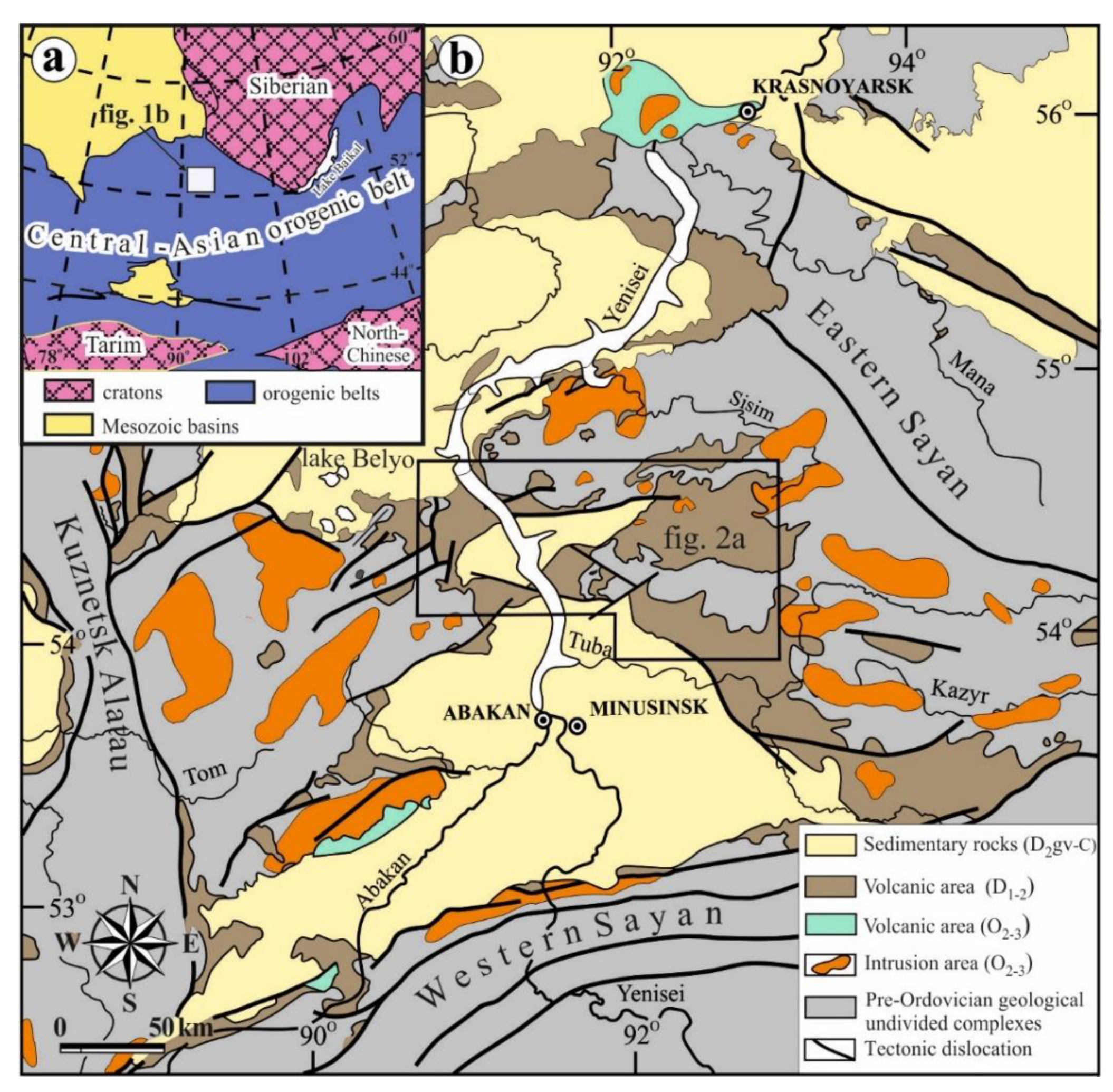
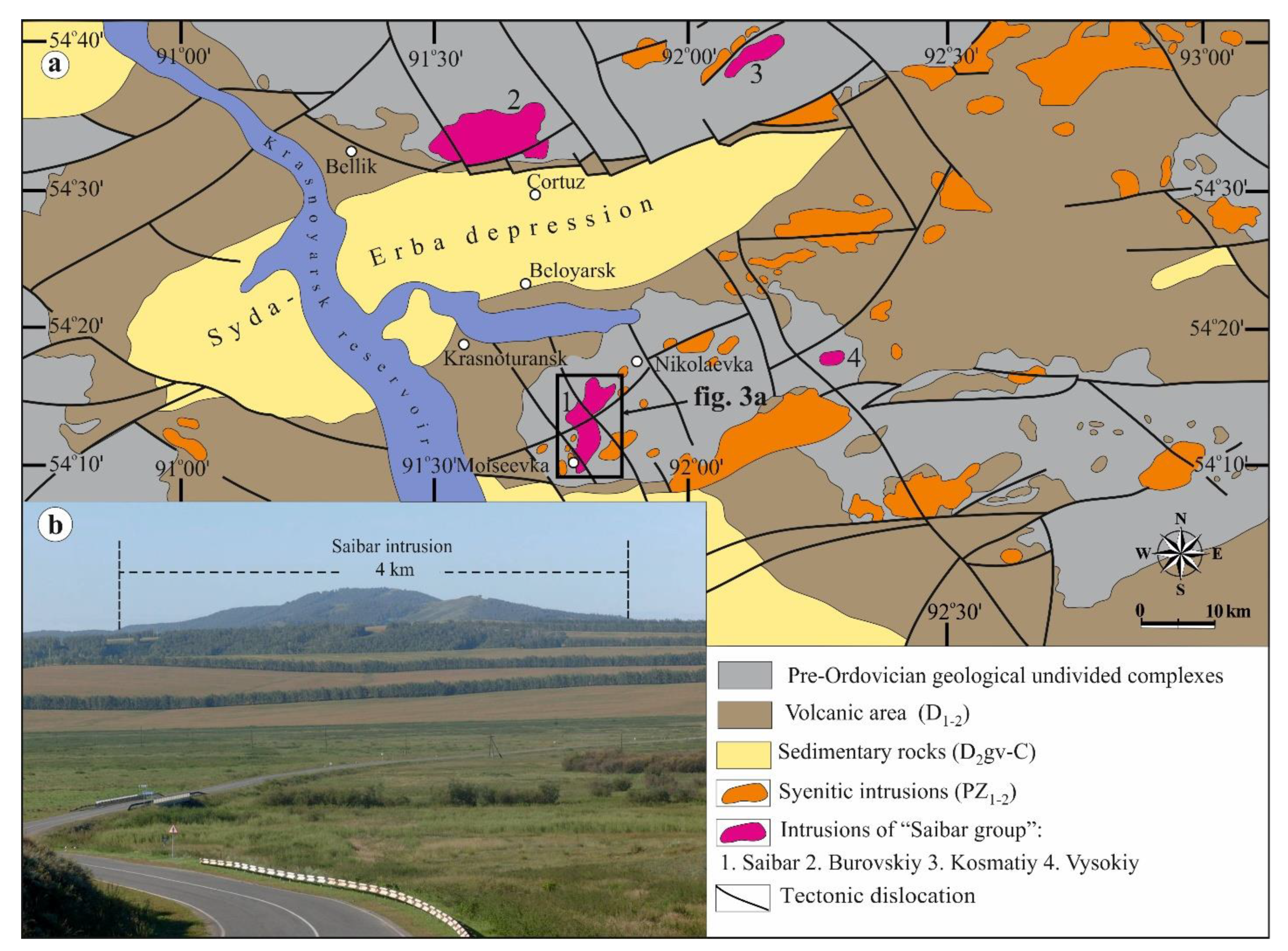

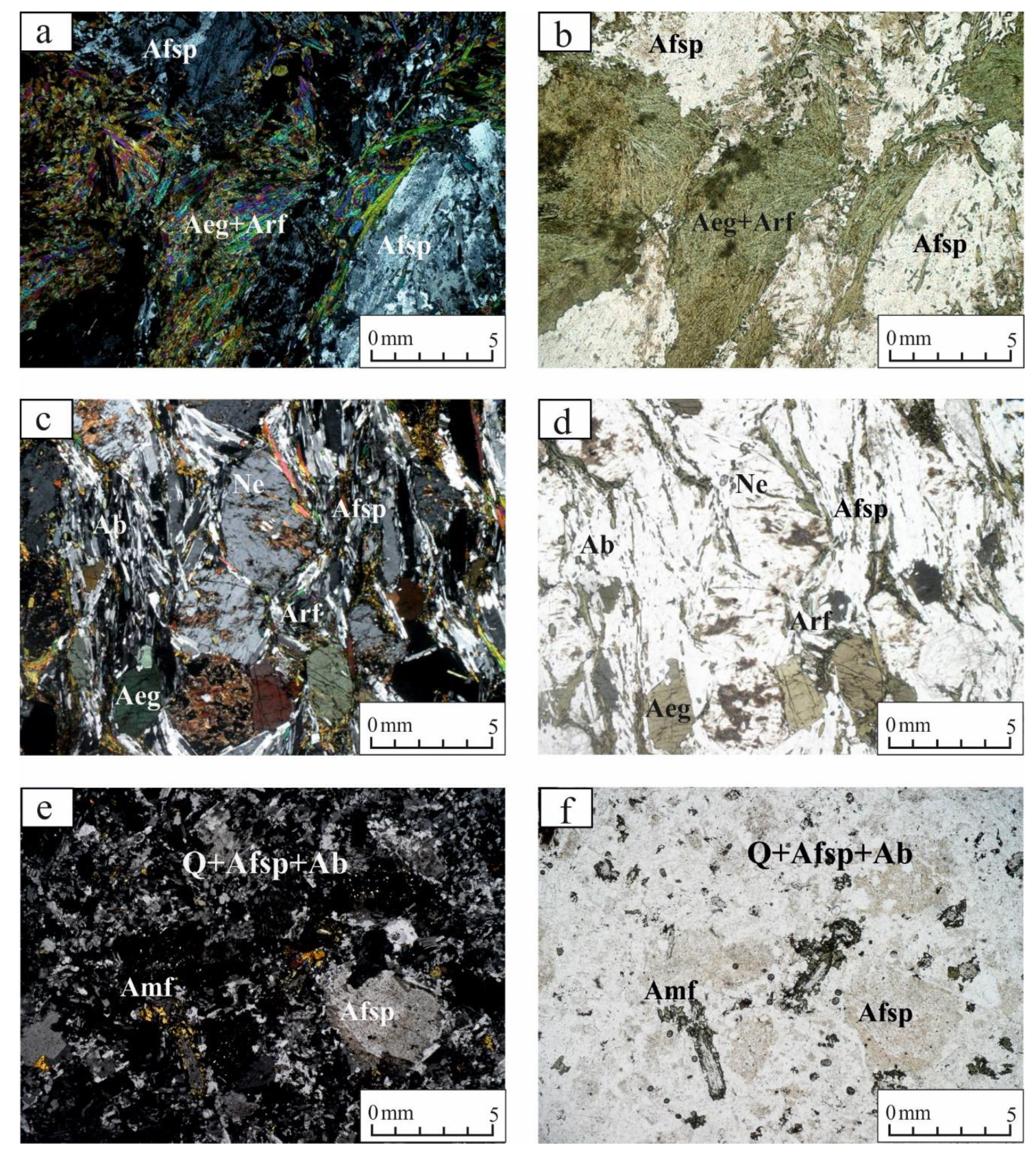
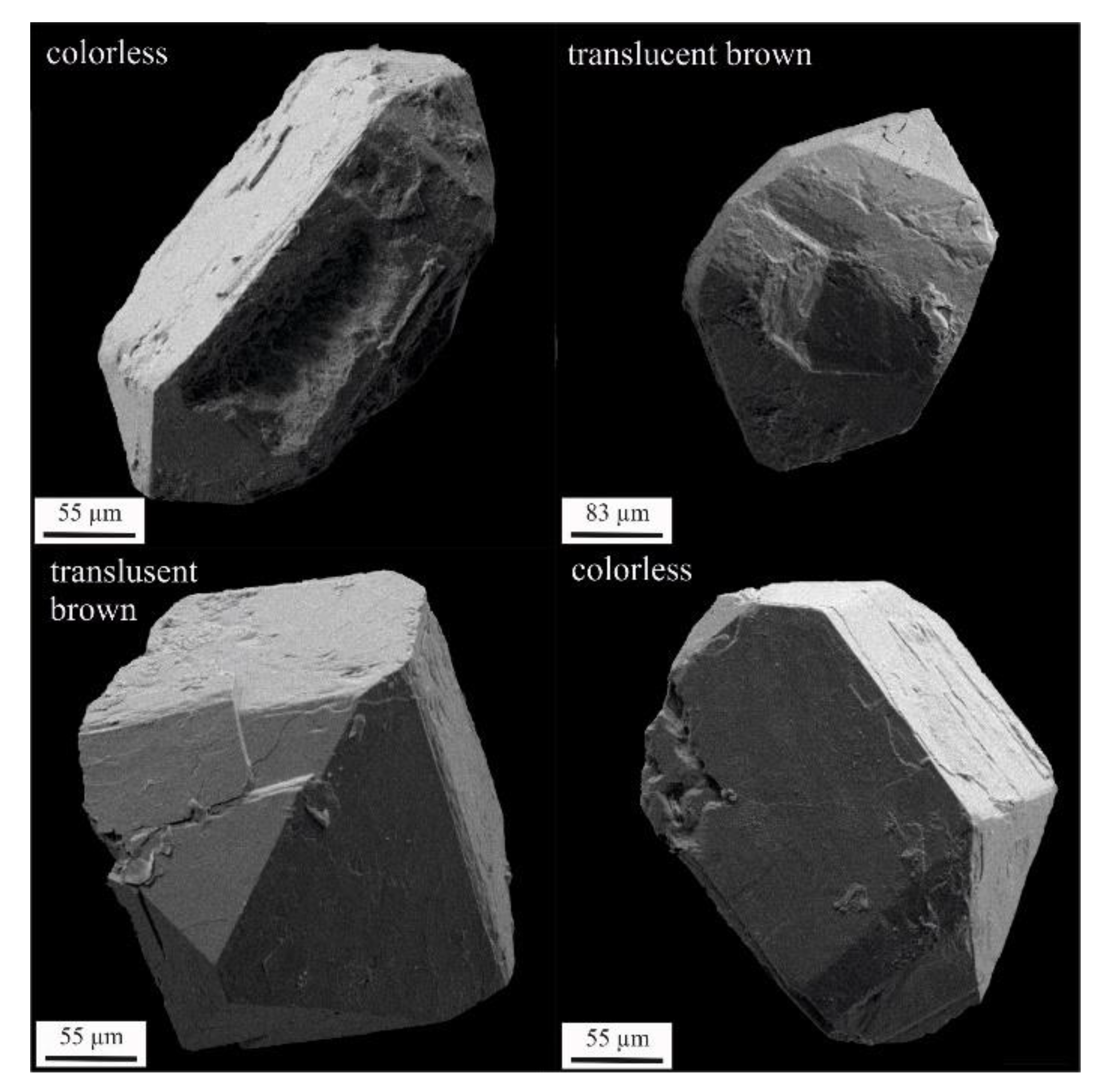
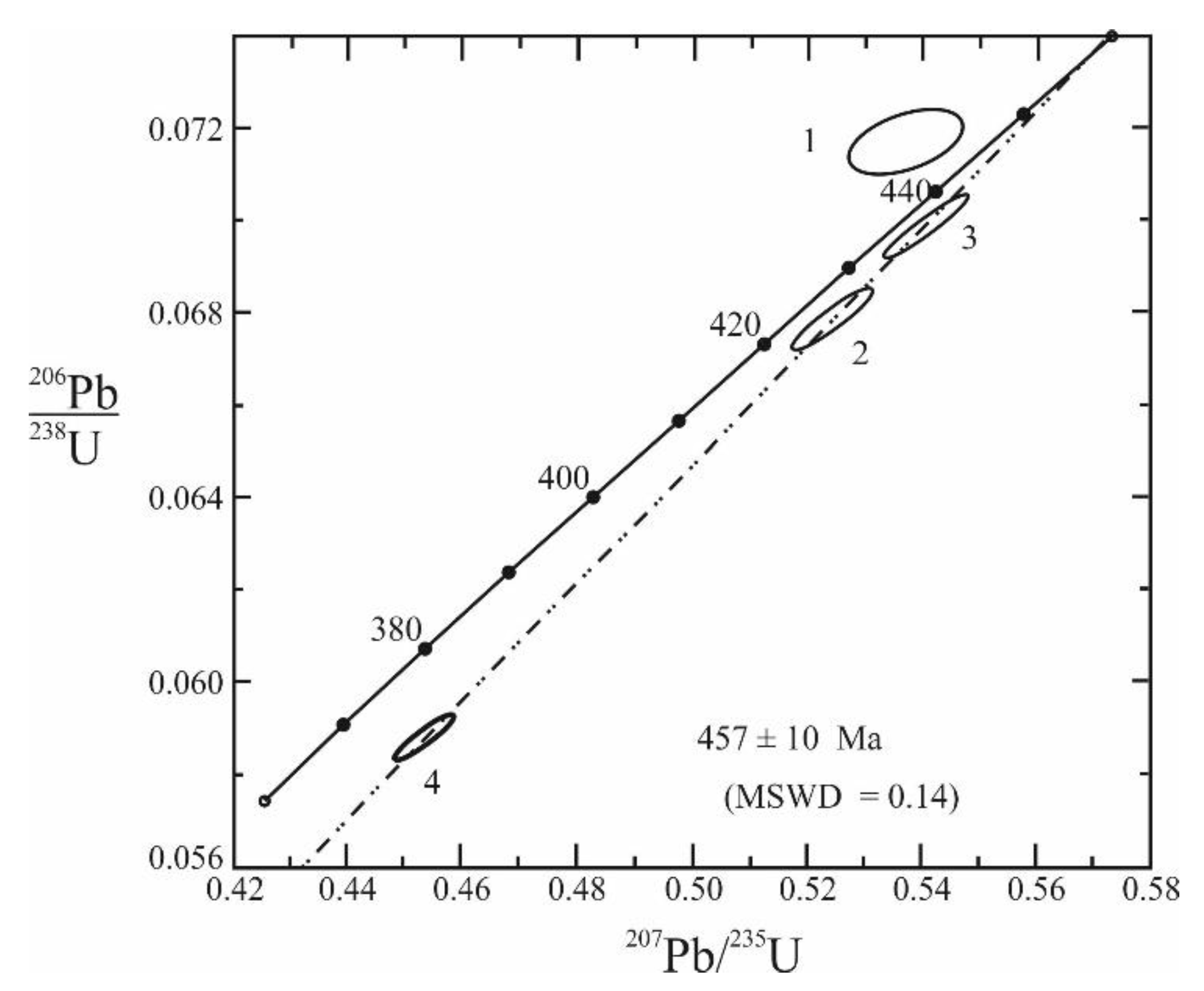
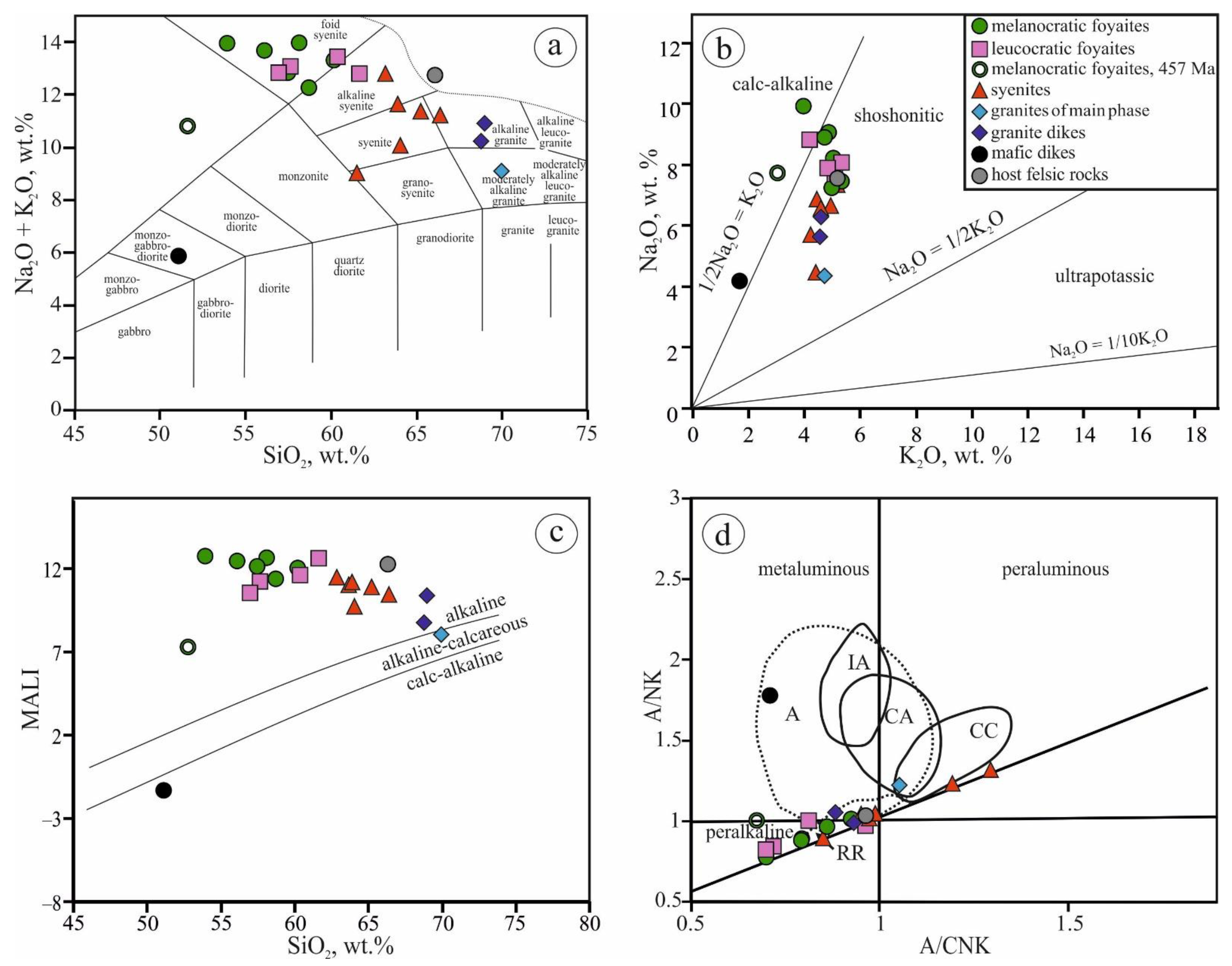
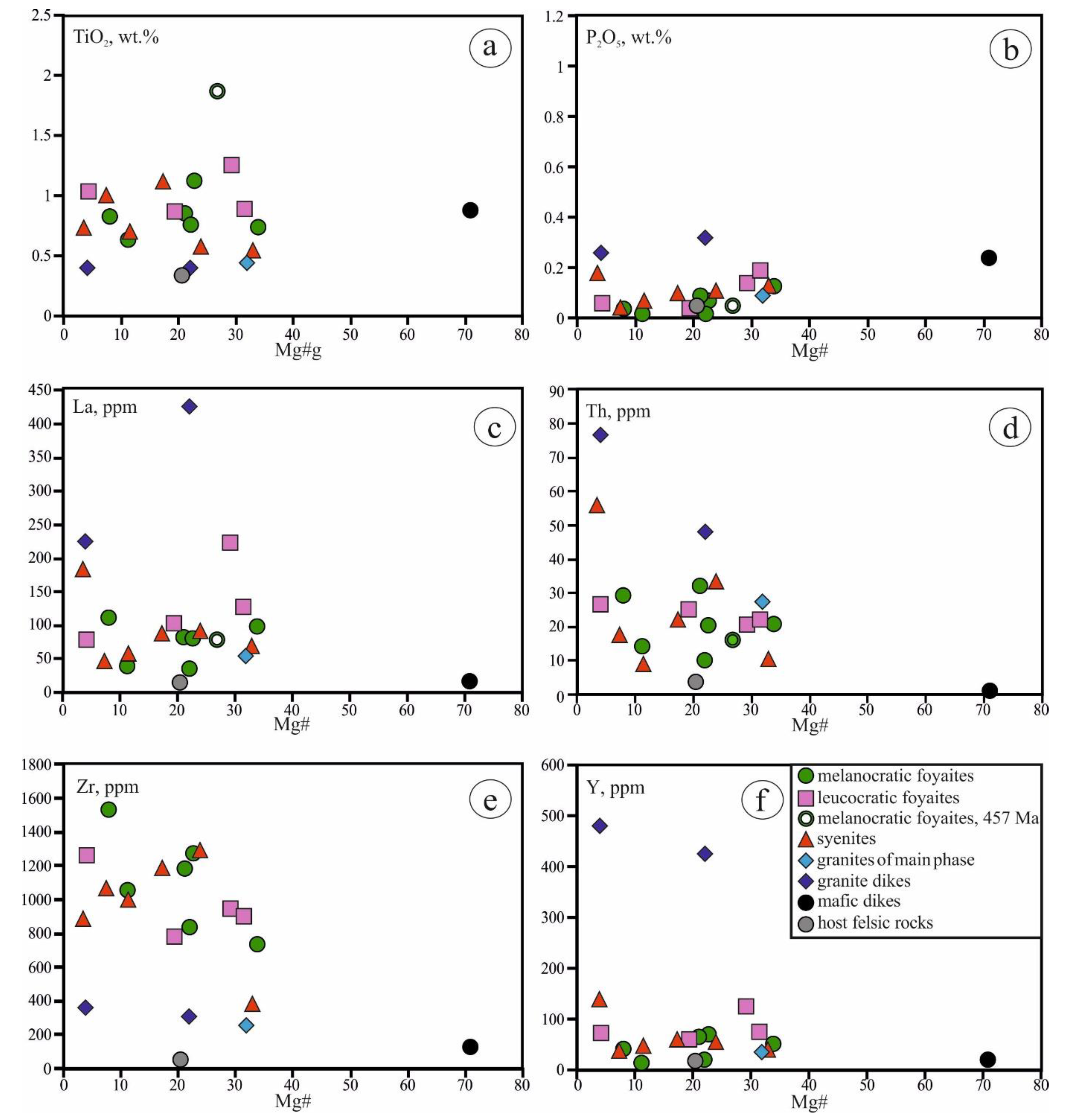
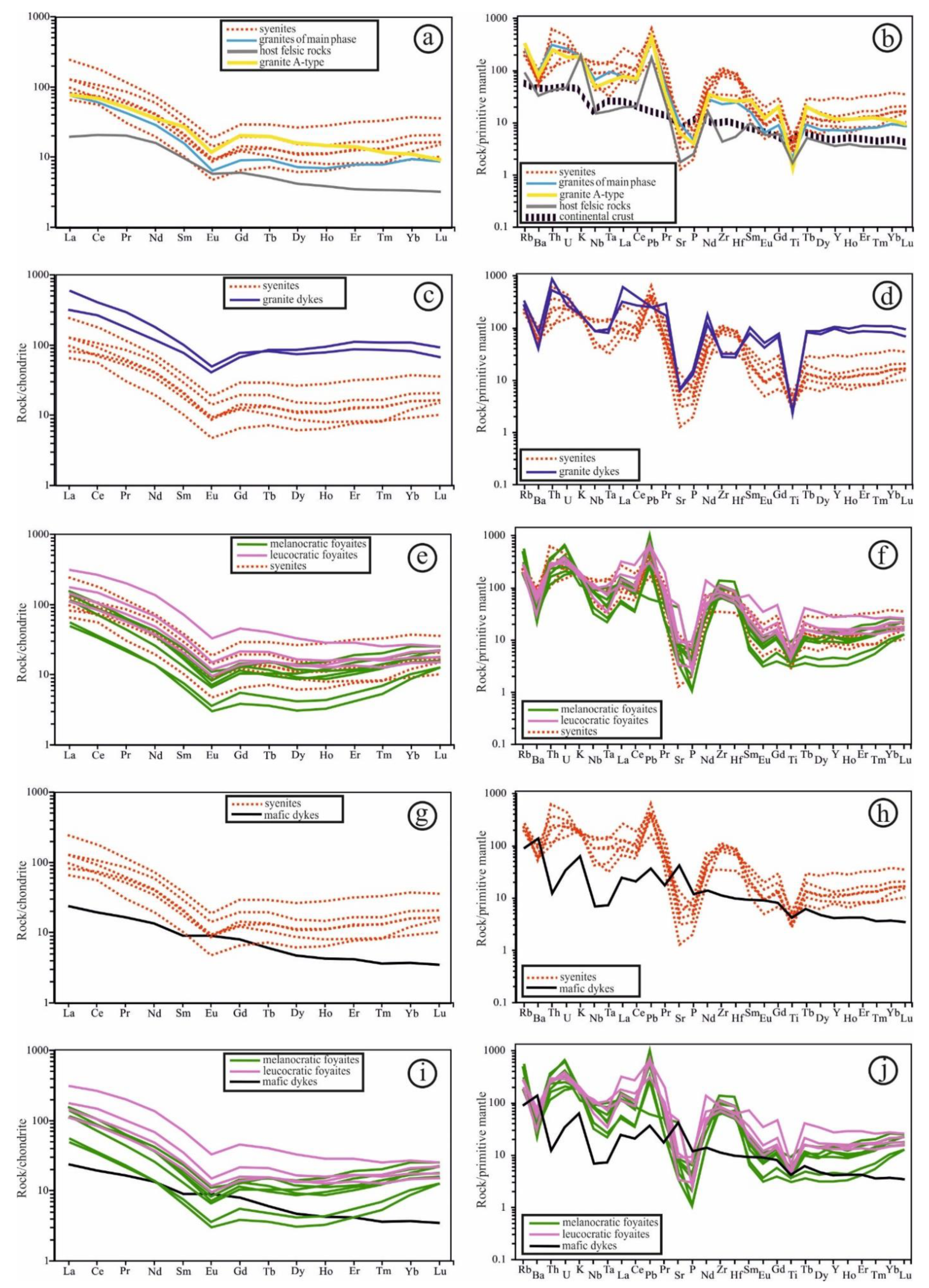
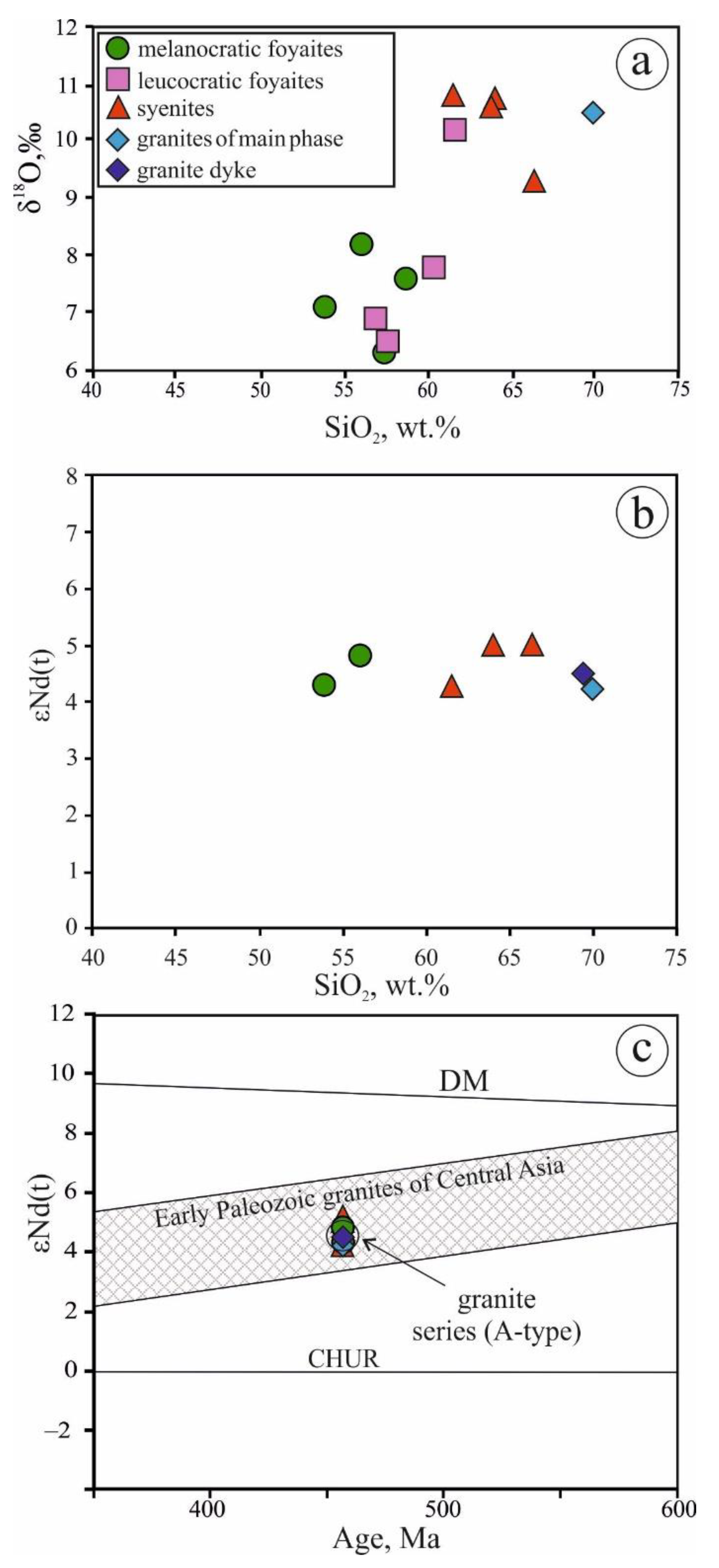
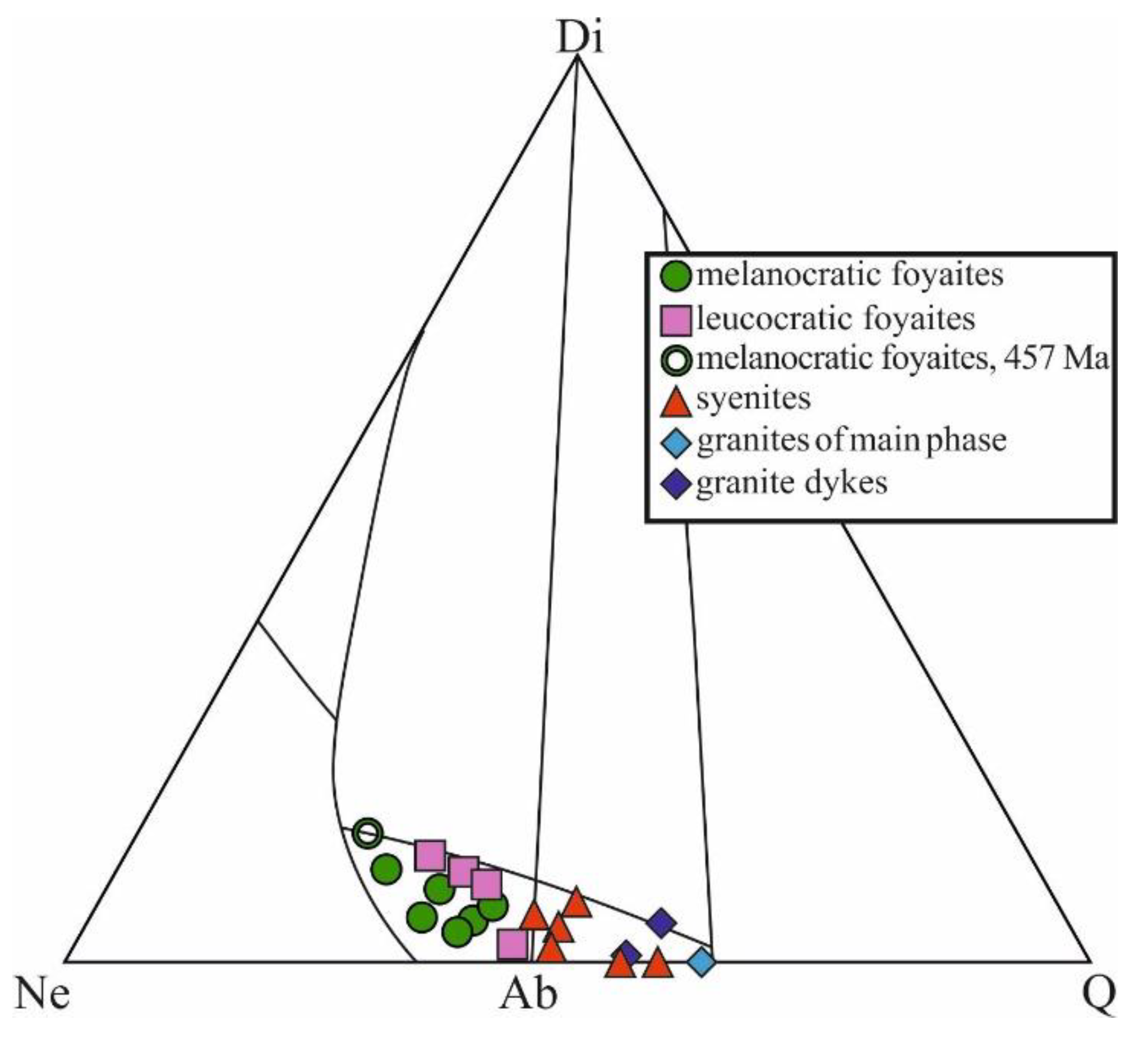
| № | Weight (mg) | Isotope Ratios | Age, Million Years | ||||||||
|---|---|---|---|---|---|---|---|---|---|---|---|
| Pb, ppm | U, ppm | 206Pba 204Pb | 207Pbb 206Pb | 208Pbb 206Pb | 206Pb 238U | 207Pb 235U | 206Pb 238U | 207Pb 235U | 207Pb 206Pb | ||
| Samples 73–99, Melanocratic Foyaite | |||||||||||
| 1 | 0.40 | 2.05 | 24.2 | 1550 | 0.054314 ± 168 | 0.27435 ± 85 | 0.07170 ± 9 | 0.5370 ± 18 | 446.4 ± 3.6 | 436.4 ± 4.4 | 384.1 ± 7.7 |
| 2 | 2.33 | 109 | 1255 | 546.5 | 0.056033 ± 31 | 0.29725 ± 17 | 0.06786 ± 10 | 0.5243 ± 8 | 423.3 ± 3.3 | 428.0 ± 4.3 | 453.7 ± 9.0 |
| 3 | 4.86 | 88 | 1095 | 3068 | 0.056116 ± 24 | 0.25625 ± 11 | 0.06987 ± 9 | 0.5406 ± 7 | 435.4 ± 3.5 | 438.8 ± 4.4 | 456.9 ± 9.1 |
| 4 | 1.48 | 148 | 2100 | 1677 | 0.056000 ± 22 | 0.29441 ± 12 | 0.05862 ± 8 | 0.4526 ± 6 | 367.2 ± 2.9 | 379.1 ± 3.8 | 452.5 ± 9.0 |
| Number | 1 | 2 | 3 | 4 | 5 | 6 | 7 | 8 |
|---|---|---|---|---|---|---|---|---|
| Sample | SBR 4/6 | SBR 1/5 | SBR 1/7 | SBR 3/1 | SBR 3/3 | SBR 4/4 | MSK 1/1 | MSK 1/2 |
| Rock Type | Syenites | Leucocratic Foyaites | ||||||
| Major Elements (wt.%) | ||||||||
| SiO2 | 63.68 | 61.52 | 64.02 | 63.86 | 66.39 | 65.21 | 57.62 | 61.64 |
| TiO2 | 0.54 | 1.00 | 0.70 | 1.11 | 0.57 | 0.73 | 1.25 | 1.03 |
| Al2O3 | 16.72 | 15.95 | 17.17 | 16.53 | 16.40 | 16.80 | 15.57 | 17.79 |
| TFe2O3 | 3.35 | 10.26 | 6.57 | 5.34 | 3.71 | 4.39 | 7.22 | 5.73 |
| MnO | 0.13 | 0.43 | 0.28 | 0.25 | 0.12 | 0.20 | 0.30 | 0.27 |
| MgO | 0.71 | 0.36 | 0.37 | 0.48 | 0.50 | 0.07 | 1.28 | 0.11 |
| CaO | 1.71 | 0.11 | 0.25 | 0.48 | 0.83 | 0.50 | 1.86 | 0.20 |
| Na2O | 7.31 | 4.48 | 5.71 | 6.66 | 6.57 | 6.87 | 8.83 | 7.89 |
| K2O | 5.41 | 4.44 | 4.25 | 4.97 | 4.63 | 4.48 | 4.22 | 4.89 |
| P2O5 | 0.13 | 0.04 | 0.07 | 0.10 | 0.11 | 0.18 | 0.14 | 0.06 |
| LOI | 0.66 | 1.43 | 0.65 | 0.71 | 0.52 | 0.93 | 1.96 | 0.54 |
| Total | 100.35 | 100.02 | 100.04 | 100.49 | 100.35 | 100.36 | 100.25 | 100.15 |
| #Mg | 33.1 | 7.5 | 11.5 | 17.4 | 24.0 | 3.6 | 29.3 | 4.3 |
| A.C. | 1.07 | 0.76 | 0.82 | 0.99 | 0.96 | 0.96 | 1.23 | 1.03 |
| A/CNK | 0.80 | 1.29 | 1.19 | 0.96 | 0.95 | 0.98 | 0.69 | 0.95 |
| A/NK | 0.93 | 1.31 | 1.23 | 1.01 | 1.04 | 1.04 | 0.82 | 0.97 |
| Na2O + K2O | 12.72 | 8.92 | 9.96 | 11.62 | 11.20 | 11.35 | 13.05 | 12.78 |
| MALI | 11.01 | 8.82 | 9.71 | 11.14 | 10.37 | 10.85 | 11.19 | 12.58 |
| Trace Elements (ppm) | ||||||||
| Rb | 175 | 174 | 125 | 153 | 148 | 151 | 175 | 131 |
| Ba | 670 | 346 | 390 | 407 | 615 | 390 | 532 | 196 |
| Th | 10.3 | 17.6 | 8.9 | 22.2 | 33.1 | 55.9 | 20.7 | 26.6 |
| U | 3.07 | 6.00 | 5.12 | 4.73 | 6.61 | 9.35 | 7.27 | 6.02 |
| Nb | 30.1 | 38.6 | 64.1 | 91.3 | 63.0 | 105.1 | 82.6 | 74.0 |
| Ta | 1.83 | 1.23 | 3.80 | 6.01 | 3.50 | 5.28 | 2.82 | 3.08 |
| La | 69.6 | 46.5 | 58.1 | 87.7 | 90.9 | 183.0 | 223.2 | 78.6 |
| Ce | 128.5 | 102.3 | 136.8 | 197.1 | 169.7 | 336.5 | 495.1 | 155.3 |
| Pb | 10.9 | 29.1 | 23.7 | 42.9 | 29.3 | 30.8 | 44.1 | 42.1 |
| Pr | 14.04 | 8.26 | 15.86 | 23.32 | 16.85 | 32.15 | 54.18 | 15.41 |
| Sr | 286 | 26 | 65 | 84 | 168 | 103 | 232 | 72 |
| Nd | 46.8 | 26.5 | 54.9 | 81.4 | 55.9 | 99.9 | 186.0 | 51.0 |
| Zr | 384 | 1065 | 996 | 1181 | 1285 | 880 | 940 | 1257 |
| Hf | 10.03 | 27.76 | 23.51 | 26.04 | 26.16 | 20.51 | 18.84 | 26.48 |
| Sm | 7.86 | 4.53 | 9.11 | 13.37 | 9.54 | 17.10 | 31.56 | 8.99 |
| Eu | 1.48 | 0.79 | 1.58 | 2.35 | 1.43 | 3.15 | 5.53 | 1.59 |
| Gd | 7.29 | 3.88 | 7.50 | 11.59 | 8.51 | 17.40 | 27.30 | 8.23 |
| Tb | 0.98 | 0.69 | 1.26 | 1.84 | 1.28 | 2.79 | 3.86 | 1.50 |
| Dy | 6.44 | 4.51 | 8.36 | 11.19 | 8.06 | 19.47 | 24.57 | 9.88 |
| Y | 38.3 | 35.8 | 47.1 | 59.4 | 53.4 | 138.0 | 123.7 | 71.3 |
| Ho | 1.30 | 1.04 | 1.84 | 2.38 | 1.78 | 4.55 | 4.68 | 2.24 |
| Er | 3.96 | 3.70 | 5.95 | 7.95 | 6.22 | 15.40 | 13.80 | 7.93 |
| Tm | 0.64 | 0.64 | 1.03 | 1.28 | 1.01 | 2.58 | 1.98 | 1.33 |
| Yb | 4.50 | 5.86 | 7.68 | 9.79 | 7.69 | 17.95 | 13.12 | 10.36 |
| Lu | 0.79 | 1.18 | 1.30 | 1.61 | 1.28 | 2.78 | 1.97 | 1.71 |
| ƩLREE | 258.9 | 183.6 | 265.7 | 389.5 | 333.4 | 651.6 | 958.5 | 300.3 |
| ƩMREE | 24.1 | 14.4 | 27.8 | 40.3 | 28.8 | 59.9 | 92.8 | 30.2 |
| ƩHREE | 11.2 | 12.4 | 17.8 | 23.0 | 18.0 | 43.3 | 35.6 | 23.6 |
| (La/Yb)n | 10.6 | 5.4 | 5.2 | 6.1 | 8.1 | 7.0 | 11.7 | 5.2 |
| Eu* | 0.59 | 0.57 | 0.57 | 0.57 | 0.48 | 0.56 | 0.57 | 0.56 |
| 9 | 10 | 11 | 12 | 13 | 14 | 15 | 16 | |
| MSK 1/3 | MSK 1/5 | SBR 1/1 | SBR 1/2 | SBR 1/3 | SBR 4/7 | SBR 4/8 | SBR 3/2 | |
| Leucocratic Foyaites | Melanocratic Foyaites | |||||||
| Major Elements (wt.%) | ||||||||
| SiO2 | 56.94 | 60.37 | 56.09 | 53.91 | 57.45 | 60.17 | 58.10 | 58.72 |
| TiO2 | 0.86 | 0.88 | 0.63 | 0.83 | 0.76 | 0.85 | 0.74 | 1.12 |
| Al2O3 | 18.12 | 16.03 | 17.36 | 15.93 | 18.54 | 16.86 | 19.40 | 17.47 |
| TFe2O3 | 5.13 | 5.07 | 8.55 | 11.27 | 7.03 | 5.31 | 3.52 | 6.21 |
| MnO | 0.25 | 0.26 | 0.20 | 0.26 | 0.26 | 0.32 | 0.26 | 0.33 |
| MgO | 0.53 | 1.01 | 0.46 | 0.42 | 0.85 | 0.61 | 0.77 | 0.78 |
| CaO | 2.30 | 1.83 | 1.21 | 1.19 | 0.70 | 1.26 | 1.33 | 0.90 |
| Na2O | 7.69 | 8.08 | 8.89 | 9.93 | 7.45 | 8.22 | 9.05 | 7.26 |
| K2O | 5.13 | 5.36 | 4.76 | 4.00 | 5.36 | 5.08 | 4.90 | 5.01 |
| P2O5 | 0.04 | 0.19 | 0.02 | 0.04 | 0.02 | 0.09 | 0.13 | 0.07 |
| LOI | 2.85 | 0.92 | 1.88 | 2.48 | 1.13 | 1.58 | 2.18 | 1.11 |
| Total | 99.84 | 100.00 | 100.05 | 100.26 | 99.55 | 100.35 | 100.38 | 98.98 |
| #Mg | 19.4 | 31.6 | 11.2 | 7.9 | 22.0 | 21.1 | 33.8 | 22.7 |
| A.C. | 1.00 | 1.19 | 1.14 | 1.30 | 0.97 | 1.13 | 1.04 | 0.99 |
| A/CNK | 0.81 | 0.71 | 0.79 | 0.70 | 0.96 | 0.79 | 0.86 | 0.92 |
| A/NK | 1.00 | 0.84 | 0.88 | 0.77 | 1.03 | 0.89 | 0.96 | 1.01 |
| Na2O + K2O | 12.82 | 13.44 | 13.65 | 13.93 | 12.81 | 13.30 | 13.95 | 12.27 |
| MALI | 10.52 | 11.61 | 12.45 | 12.74 | 12.11 | 12.04 | 12.62 | 11.37 |
| Trace Elements (ppm) | ||||||||
| Rb | 190 | 178 | 339 | 320 | 365 | 199 | 195 | 181 |
| Ba | 362 | 459 | 159 | 125 | 204 | 338 | 222 | 490 |
| Th | 25.0 | 22.0 | 14.4 | 29.4 | 10.2 | 32.3 | 21.0 | 20.7 |
| U | 7.04 | 8.25 | 4.38 | 13.95 | 3.71 | 13.42 | 8.86 | 5.33 |
| Nb | 44.6 | 68.1 | 22.8 | 56.6 | 29.6 | 63.0 | 59.0 | 68.4 |
| Ta | 1.33 | 4.36 | 0.86 | 1.74 | 1.04 | 1.60 | 2.34 | 3.32 |
| La | 103.0 | 126.2 | 39.6 | 112.3 | 35.2 | 82.1 | 98.3 | 81.6 |
| Ce | 194.1 | 273.5 | 65.5 | 195.3 | 61.9 | 130.7 | 162.5 | 155.4 |
| Pb | 48.6 | 20.7 | 22.1 | 47.2 | 17.4 | 68.0 | 35.7 | 47.9 |
| Pr | 19.99 | 27.49 | 6.23 | 17.15 | 5.89 | 11.83 | 15.76 | 15.84 |
| Sr | 991 | 190 | 169 | 98 | 76 | 165 | 182 | 156 |
| Nd | 66.7 | 93.7 | 19.0 | 49.9 | 18.7 | 35.4 | 49.5 | 51.2 |
| Zr | 779 | 899 | 1053 | 1533 | 839 | 1181 | 735 | 1272 |
| Hf | 16.12 | 20.14 | 26.73 | 40.12 | 18.56 | 26.97 | 15.27 | 27.18 |
| Sm | 11.35 | 15.66 | 2.90 | 7.78 | 3.36 | 5.81 | 7.34 | 8.60 |
| Eu | 1.95 | 2.51 | 0.50 | 1.36 | 0.59 | 1.10 | 1.19 | 1.54 |
| Gd | 9.38 | 12.67 | 2.29 | 7.82 | 3.31 | 6.10 | 6.80 | 8.44 |
| Tb | 1.49 | 1.99 | 0.34 | 1.12 | 0.46 | 0.99 | 0.93 | 1.43 |
| Dy | 10.25 | 12.31 | 2.27 | 6.74 | 3.09 | 7.74 | 6.41 | 10.33 |
| Y | 59.4 | 73.7 | 14.2 | 41.8 | 20.5 | 65.6 | 52.6 | 70.8 |
| Ho | 2.08 | 2.57 | 0.53 | 1.41 | 0.70 | 1.94 | 1.55 | 2.47 |
| Er | 6.52 | 8.06 | 1.97 | 4.92 | 2.65 | 7.20 | 5.39 | 9.25 |
| Tm | 0.99 | 1.23 | 0.42 | 0.94 | 0.53 | 1.32 | 0.97 | 1.57 |
| Yb | 7.14 | 8.58 | 4.25 | 8.71 | 4.92 | 9.95 | 7.26 | 12.35 |
| Lu | 1.19 | 1.38 | 0.98 | 1.71 | 0.99 | 1.73 | 1.24 | 1.96 |
| ƩLREE | 383.8 | 520.9 | 130.3 | 374.7 | 121.7 | 260.0 | 326.1 | 304.0 |
| ƩMREE | 34.4 | 45.1 | 8.3 | 24.8 | 10.8 | 21.7 | 22.7 | 30.3 |
| ƩHREE | 17.9 | 21.8 | 8.2 | 17.7 | 9.8 | 22.1 | 16.4 | 27.6 |
| (La/Yb)n | 9.9 | 10.1 | 6.4 | 8.8 | 4.9 | 5.7 | 9.3 | 4.5 |
| Eu* | 0.56 | 0.53 | 0.58 | 0.53 | 0.54 | 0.57 | 0.51 | 0.55 |
| 17 | 18 | 19 | 20 | 21 | 22 | 23 | 24 | |
| 73–99 | SBR 1/4 | SBR 4/1 | SBR 4/3 | SBR 4/9 | SBR 4/17 | SBR 4/14 | ||
| Melanocratic Foyaites | Granite of Main Phase | Granites of Dykes | Mafic Dyke | Host Felsic Rock | Host Limestone | Hybrid Melt | ||
| Major Elements (wt.%) | ||||||||
| SiO2 | 52.71 | 69.93 | 68.75 | 68.94 | 51.08 | 66.30 | 0.1 | 59.40 |
| TiO2 | 1.87 | 0.43 | 0.39 | 0.39 | 0.87 | 0.33 | 0.01 | 1.03 |
| Al2O3 | 15.92 | 14.91 | 14.96 | 15.12 | 15.50 | 18.38 | 0.15 | 15.38 |
| TFe2O3 | 8.73 | 2.92 | 2.75 | 3.04 | 7.58 | 1.53 | <0.5 | |
| MnO | 0.64 | 0.08 | 0.18 | 0.09 | 0.11 | 0.03 | 0.01 | 0.23 |
| MgO | 1.37 | 0.59 | 0.05 | 0.37 | 7.96 | 0.17 | 0.39 | 0.47 |
| CaO | 3.55 | 1.07 | 1.52 | 0.53 | 7.20 | 0.59 | 59.1 | 4.58 |
| Na2O | 7.79 | 4.34 | 5.64 | 6.28 | 4.21 | 7.58 | <0.1 | |
| K2O | 3.06 | 4.75 | 4.60 | 4.63 | 1.66 | 5.22 | 0.04 | 4.62 |
| P2O5 | 0.05 | 0.09 | 0.26 | 0.32 | 0.24 | 0.05 | 0.02 | 0.09 |
| LOI | 3.99 | 0.60 | 1.29 | 0.70 | 3.89 | 0.29 | 39.77 | 3.44 |
| Total | 99.68 | 99.71 | 100.39 | 100.41 | 100.30 | 100.47 | 99.59 | 100.43 |
| #Mg | 26.8 | 31.9 | 4.1 | 22.1 | 71.0 | 20.6 | ||
| A.C. | 1.23 | 0.82 | 0.95 | 1.01 | 0.56 | 0.99 | ||
| A/CNK | 0.70 | 1.05 | 0.88 | 0.93 | 0.71 | 0.96 | ||
| A/NK | 0.99 | 1.21 | 1.05 | 0.99 | 1.78 | 1.01 | ||
| Na2O + K2O | 10.85 | 9.09 | 10.24 | 10.91 | 5.87 | 12.80 | ||
| MALI | 7.30 | 8.02 | 8.72 | 10.38 | −1.33 | 12.21 | ||
| Trace Elements (ppm) | ||||||||
| Rb | 116 | 158 | 204 | 186 | 54 | 57 | 0.86 | 142.35 |
| Ba | 265 | 612 | 541 | 279 | 953 | 229 | 17.5 | 379.7 |
| Th | 16.2 | 27.4 | 76.3 | 47.8 | 1.0 | 3.7 | 0.1 | 20.6 |
| U | 7.08 | 5.37 | 5.76 | 8.17 | 0.71 | 0.99 | 0.79 | 4.45 |
| Nb | 46.0 | 61.1 | 59.5 | 4.9 | 10.9 | 0.16 | 84.92 | |
| Ta | 4.06 | 3.85 | 3.78 | 3.31 | 0.29 | 0.67 | ||
| La | 79.3 | 53.3 | 224.8 | 424.7 | 17.0 | 13.8 | 0.42 | 81.59 |
| Ce | 154.1 | 111.5 | 490.4 | 750.0 | 36.0 | 38.5 | 0.78 | 183.36 |
| Pb | 25.7 | 16.9 | 16.9 | 2.5 | 11.7 | 1.15 | 39.98 | |
| Pr | 11.57 | 47.96 | 79.46 | 4.48 | 5.48 | 0.14 | 21.70 | |
| Sr | 925 | 201 | 128 | 132 | 901 | 36 | 335 | 101 |
| Nd | 58.1 | 38.9 | 160.8 | 248.6 | 18.6 | 21.9 | 0.54 | 75.74 |
| Zr | 254 | 354 | 305 | 124 | 49 | 3.8 | 1098 | |
| Hf | 22.13 | 7.57 | 9.86 | 8.38 | 3.02 | 1.65 | 0.05 | 24.22 |
| Sm | 10.37 | 7.00 | 34.80 | 45.20 | 4.03 | 4.27 | 0.08 | 12.44 |
| Eu | 1.84 | 1.06 | 6.74 | 8.33 | 1.51 | 0.96 | 0.03 | 2.19 |
| Gd | 7.59 | 5.31 | 40.04 | 46.09 | 4.69 | 3.57 | 0.11 | 10.79 |
| Tb | 1.47 | 0.88 | 8.15 | 7.84 | 0.58 | 0.49 | 0.01 | 1.71 |
| Dy | 5.28 | 63.00 | 54.99 | 3.47 | 3.06 | 0.09 | 10.41 | |
| Y | 33.0 | 479.9 | 423.4 | 18.7 | 16.3 | 0.67 | 55.29 | |
| Ho | 1.13 | 15.52 | 12.85 | 0.69 | 0.63 | 0.02 | 2.21 | |
| Er | 3.76 | 53.57 | 42.05 | 2.01 | 1.67 | |||
| Tm | 1.10 | 0.61 | 8.41 | 6.59 | 0.28 | 0.27 | 0.01 | 1.19 |
| Yb | 8.18 | 4.57 | 52.61 | 39.72 | 1.80 | 1.62 | 0.05 | 9.11 |
| Lu | 1.41 | 0.67 | 7.25 | 5.28 | 0.27 | 0.25 | 0.01 | 1.50 |
| ƩLREE | 215.3 | 924.0 | 1502.8 | 76.1 | 79.7 | |||
| ƩMREE | 19.5 | 152.7 | 162.5 | 14.3 | 12.4 | |||
| ƩHREE | 10.7 | 137.4 | 106.5 | 5.1 | 4.4 | |||
| (La/Yb)n | 6.6 | 8.0 | 2.9 | 7.3 | 1.3 | 5.8 | ||
| Eu* | 0.60 | 0.52 | 0.56 | 0.56 | 1.07 | 0.74 | ||
| Number | Sample | Sm, ppm | Nd, ppm | 147Sm/ 144Nd | 143Nd/ 144Nd | ε(T) | Age, Ma | δ18O,‰ |
|---|---|---|---|---|---|---|---|---|
| Syenites | ||||||||
| 2 | SBR 1/5 | 4.28 | 25.52 | 0.10215 | 0.51257 | 4.1 | 457 | 10.8 |
| 3 | SBR 1/7 | 8.23 | 49.51 | 0.10124 | 0.51261 | 4.9 | 457 | 10.7 |
| 4 | SBR 3/1 | 10.6 | ||||||
| 5 | SBR 3/3 | 8.44 | 52.54 | 0.09786 | 0.5126 | 5 | 457 | 9.3 |
| Leucocratic Foyaites | ||||||||
| 7 | MSK 1/1 | 6.5 | ||||||
| 8 | MSK 1/2 | 10.2 | ||||||
| 9 | MSK 1/3 | 6.9 | ||||||
| 10 | MSK 1/5 | 7.8 | ||||||
| Melanocratic Foyaites | ||||||||
| 11 | SBR 1/1 | 2.47 | 15.7 | 0.09593 | 0.51258 | 4.8 | 457 | 8.2 |
| 12 | SBR 1/2 | 6.7 | 42.44 | 0.09616 | 0.51256 | 4.3 | 457 | 7.1 |
| 13 | SBR 1/3 | 6.3 | ||||||
| 16 | SBR 3/2 | 7.6 | ||||||
| Granite of the Main Phase | ||||||||
| 18 | SBR 1/4 | 6.32 | 38.34 | 0.10036 | 0.51256 | 4.1 | 457 | 10.5 |
| Dyke Granites | ||||||||
| 20 | SBR 4/3 | 27.28 | 233 | 0.07047 | 0.512492 | 4.5 | 457 | |
Publisher’s Note: MDPI stays neutral with regard to jurisdictional claims in published maps and institutional affiliations. |
© 2021 by the authors. Licensee MDPI, Basel, Switzerland. This article is an open access article distributed under the terms and conditions of the Creative Commons Attribution (CC BY) license (https://creativecommons.org/licenses/by/4.0/).
Share and Cite
Vorontsov, A.A.; Izoh, A.E.; Yarmolyuk, V.V.; Komaritsyna, T.Y.; Nikiforov, A.V.; Perfilova, O.Y.; Dril, S.I.; Rizvanova, N.G.; Dushkin, E.P. Evolution of Syenite Magmas: Insights from the Geology, Geochemistry and O-Nd Isotopic Characteristics of the Ordovician Saibar Intrusion, Altai-Sayan Area, Russia. Minerals 2021, 11, 473. https://doi.org/10.3390/min11050473
Vorontsov AA, Izoh AE, Yarmolyuk VV, Komaritsyna TY, Nikiforov AV, Perfilova OY, Dril SI, Rizvanova NG, Dushkin EP. Evolution of Syenite Magmas: Insights from the Geology, Geochemistry and O-Nd Isotopic Characteristics of the Ordovician Saibar Intrusion, Altai-Sayan Area, Russia. Minerals. 2021; 11(5):473. https://doi.org/10.3390/min11050473
Chicago/Turabian StyleVorontsov, Alexander A., Andrey E. Izoh, Vladimir V. Yarmolyuk, Tatyana Y. Komaritsyna, Anatoly V. Nikiforov, Olga Y. Perfilova, Sergei I. Dril, Nailya G. Rizvanova, and Egor P. Dushkin. 2021. "Evolution of Syenite Magmas: Insights from the Geology, Geochemistry and O-Nd Isotopic Characteristics of the Ordovician Saibar Intrusion, Altai-Sayan Area, Russia" Minerals 11, no. 5: 473. https://doi.org/10.3390/min11050473
APA StyleVorontsov, A. A., Izoh, A. E., Yarmolyuk, V. V., Komaritsyna, T. Y., Nikiforov, A. V., Perfilova, O. Y., Dril, S. I., Rizvanova, N. G., & Dushkin, E. P. (2021). Evolution of Syenite Magmas: Insights from the Geology, Geochemistry and O-Nd Isotopic Characteristics of the Ordovician Saibar Intrusion, Altai-Sayan Area, Russia. Minerals, 11(5), 473. https://doi.org/10.3390/min11050473




